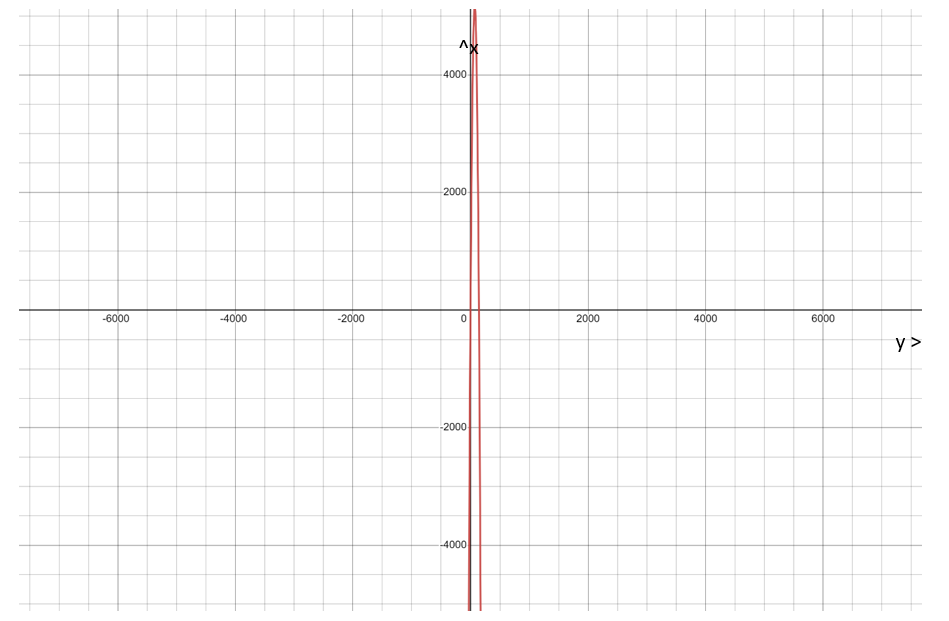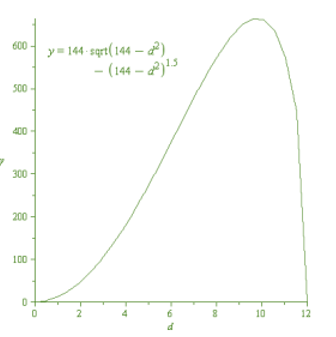
a.
To find: To find the dimensions of the width and depth.
a.
Answer to Problem 37E
The width are
Explanation of Solution
Given:
The strength S of a rectangle wooden beam is proportional to its width times the square of its depth.
Where S,w,d,k are the strength, width, depth and a constant respectively.
Concept Used: Pythagoras Thoerem.
Calculation:
Considering the figure, by Pythagoras theorem
The square of the hypotenuse is equal to the sum of square of adjacent side and opposite side.
Substituting
For any function
Substituting
Since
The critical points occurs at
For maximum strength, the dimensions are width is
b.
To find: To find the dimensions of the width.
b.
Answer to Problem 37E
The width are
Explanation of Solution
Given:
The strength S of a rectangle wooden beam is proportional to its width times the square of its depth.
Where S,w,d,k are the strength, width, depth and a constant respectively.
Calculation:

Plotting the graph between S and w
For maximum strength, the dimensions are width is
It is same as obtained in a.
b.
To find: To find the dimensions of the depth.
b.
Answer to Problem 37E
The depth is
Explanation of Solution
Given:
The strength S of a rectangle wooden beam is proportional to its width times the square of its depth.
Where S,w,d,k are the strength, width, depth and a constant respectively.
Calculation:

Plotting the graph between S and d.
For maximum strength, the dimensions are depth is
It is same as obtained in a.
The change in the value of k, will change the maximum strength but it will not change the dimension of the strongest beam, since dimensions are independent of k. For different values of k, the graph will be same expect that the vertical scale will be different.
Chapter 4 Solutions
Advanced Placement Calculus Graphical Numerical Algebraic Sixth Edition High School Binding Copyright 2020
- (8) (12 points) (a) (8 points) Let C be the circle x² + y² = 4. Let F(x, y) = (2y + e²)i + (x + sin(y²))j. Evaluate the line integral JF. F.ds. Hint: First calculate V x F. (b) (4 points) Let S be the surface r² + y² + z² = 4, z ≤0. Calculate the flux integral √(V × F) F).dS. Justify your answer.arrow_forwardDetermine whether the Law of Sines or the Law of Cosines can be used to find another measure of the triangle. a = 13, b = 15, C = 68° Law of Sines Law of Cosines Then solve the triangle. (Round your answers to four decimal places.) C = 15.7449 A = 49.9288 B = 62.0712 × Need Help? Read It Watch Itarrow_forward(4) (10 points) Evaluate √(x² + y² + z²)¹⁄² exp[}(x² + y² + z²)²] dV where D is the region defined by 1< x² + y²+ z² ≤4 and √√3(x² + y²) ≤ z. Note: exp(x² + y²+ 2²)²] means el (x²+ y²+=²)²]¸arrow_forward
- (2) (12 points) Let f(x,y) = x²e¯. (a) (4 points) Calculate Vf. (b) (4 points) Given x directional derivative 0, find the line of vectors u = D₁f(x, y) = 0. (u1, 2) such that the - (c) (4 points) Let u= (1+3√3). Show that Duƒ(1, 0) = ¦|▼ƒ(1,0)| . What is the angle between Vf(1,0) and the vector u? Explain.arrow_forwardFind the missing values by solving the parallelogram shown in the figure. (The lengths of the diagonals are given by c and d. Round your answers to two decimal places.) a b 29 39 66.50 C 17.40 d 0 54.0 126° a Ꮎ b darrow_forward(5) (10 points) Let D be the parallelogram in the xy-plane with vertices (0, 0), (1, 1), (1, 1), (0, -2). Let f(x,y) = xy/2. Use the linear change of variables T(u, v)=(u,u2v) = (x, y) 1 to calculate the integral f(x,y) dA= 0 ↓ The domain of T is a rectangle R. What is R? |ǝ(x, y) du dv. |ð(u, v)|arrow_forward
- 2 Anot ined sove in peaper PV+96252 Q3// Find the volume of the region between the cylinder z = y2 and the xy- plane that is bounded by the planes x=1, x=2,y=-2,andy=2. vertical rect a Q4// Draw and Evaluate Soxy-2sin (ny2)dydx D Lake tarrow_forwardDetermine whether the Law of Sines or the Law of Cosines can be used to find another measure of the triangle. B 13 cm 97° Law of Sines Law of Cosines A 43° Then solve the triangle. (Round your answers to two decimal places.) b = x C = A = 40.00arrow_forwardFind the missing values by solving the parallelogram shown in the figure. (The lengths of the diagonals are given by c and d. Round your answers to two decimal places.) a 29 b 39 d Ꮎ 126° a Ꮎ b darrow_forward
- A retractable awning above a patio lowers at an angle of 50° from the exterior wall at a height of y = 11 feet above the ground. No direct sunlight is to enter the door when the angle of elevation of the sun is greater than 70° (see figure). What is the length x of the awning? (Round your answer to two decimal places.) x = ft 7507 Suns rays 70°arrow_forwardhelp and show work plsarrow_forwardTwo ships leave a port at 9 a.m. One travels at a bearing of N 53° W at 10 miles per hour, and the other travels at a bearing of S 67° W at 14 miles per hour. Approximate how far apart they are at noon that day. (Round your answer to one decimal place.) miarrow_forward
 Calculus: Early TranscendentalsCalculusISBN:9781285741550Author:James StewartPublisher:Cengage Learning
Calculus: Early TranscendentalsCalculusISBN:9781285741550Author:James StewartPublisher:Cengage Learning Thomas' Calculus (14th Edition)CalculusISBN:9780134438986Author:Joel R. Hass, Christopher E. Heil, Maurice D. WeirPublisher:PEARSON
Thomas' Calculus (14th Edition)CalculusISBN:9780134438986Author:Joel R. Hass, Christopher E. Heil, Maurice D. WeirPublisher:PEARSON Calculus: Early Transcendentals (3rd Edition)CalculusISBN:9780134763644Author:William L. Briggs, Lyle Cochran, Bernard Gillett, Eric SchulzPublisher:PEARSON
Calculus: Early Transcendentals (3rd Edition)CalculusISBN:9780134763644Author:William L. Briggs, Lyle Cochran, Bernard Gillett, Eric SchulzPublisher:PEARSON Calculus: Early TranscendentalsCalculusISBN:9781319050740Author:Jon Rogawski, Colin Adams, Robert FranzosaPublisher:W. H. Freeman
Calculus: Early TranscendentalsCalculusISBN:9781319050740Author:Jon Rogawski, Colin Adams, Robert FranzosaPublisher:W. H. Freeman
 Calculus: Early Transcendental FunctionsCalculusISBN:9781337552516Author:Ron Larson, Bruce H. EdwardsPublisher:Cengage Learning
Calculus: Early Transcendental FunctionsCalculusISBN:9781337552516Author:Ron Larson, Bruce H. EdwardsPublisher:Cengage Learning





